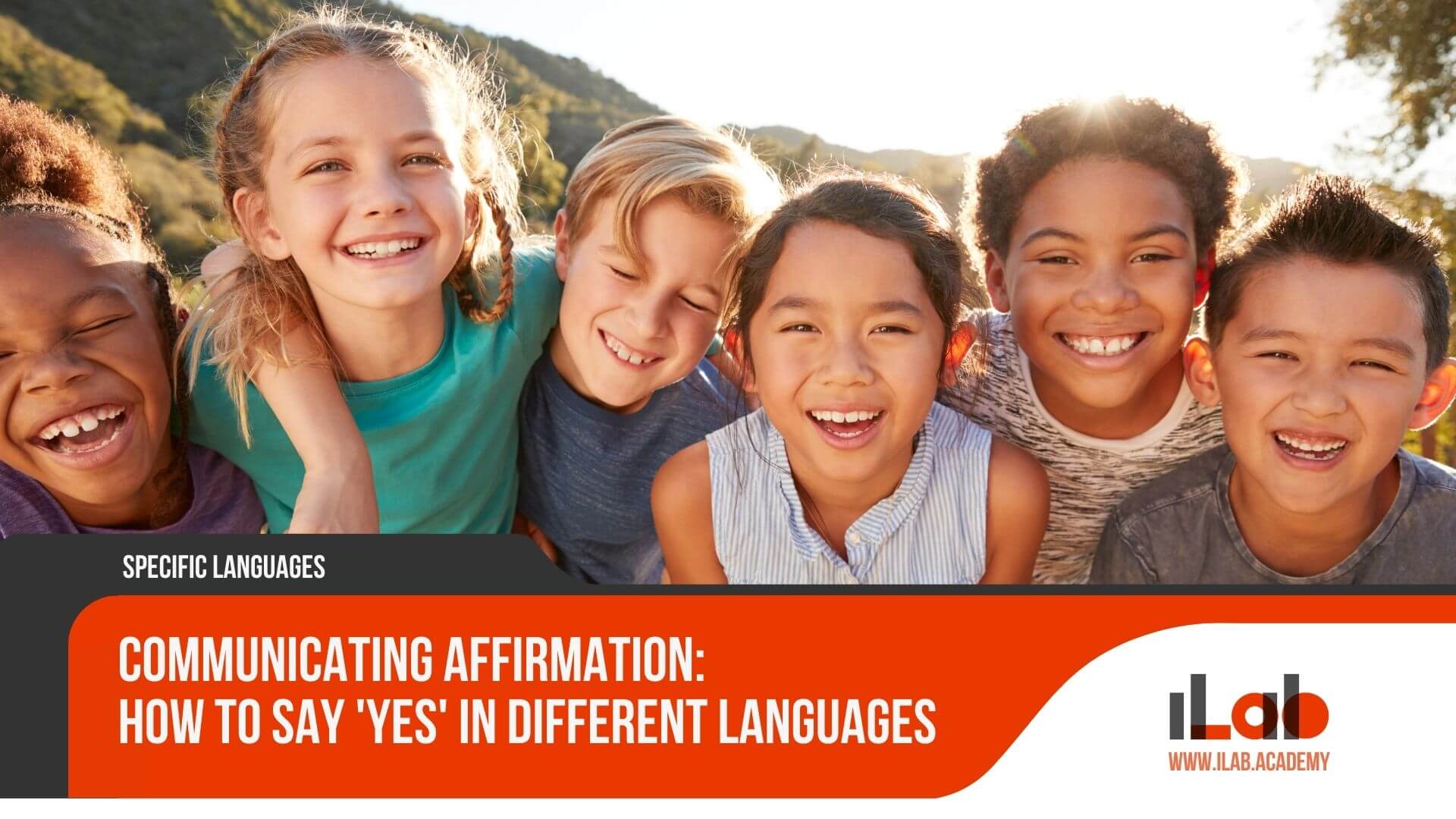Table of contents
In the intricate tapestry of human interaction, the power of a simple affirmation cannot be overstated. Expressing agreement or consent with a ‘yes’ might seem trivial, yet this act is deeply embedded in the very fabric of social exchange. This article seeks to unravel the linguistic threads of affirmation by exploring the word ‘yes’ in various linguistic landscapes across the globe. As we examine the phonetic diversity and cultural nuances that shape the way communities signal agreement, a question arises: what can the manner in which people say ‘yes’ reveal about their cultural identity and communicative style? By casting a scholarly eye over the linguistic structures and societal customs tied to this universal concept, we can uncover layers of meaning that extend beyond the mere act of assenting. Join us in navigating the richly varied expressions of confirmation and assent that resonate in the spoken word from continent to continent.
Key Takeaways
- The word ‘yes’ is essential in communication across cultures and plays a significant role in enabling consent, agreement, and positive responses.
- Different languages have various ways of expressing ‘yes’, reflecting cultural attitudes towards affirmation and showcasing linguistic diversity.
- Indo-European languages, such as English, Spanish, French, and Russian, have common ways of saying ‘yes’, but there may be subtle differences in pronunciation and usage.
- Asian languages, including Mandarin, Hindi, Turkish, and Japanese, have their own unique expressions for ‘yes’, influenced by language families like Sino-Tibetan, Dravidian, and Altaic.
The Significance of ‘Yes
The word ‘yes’ plays a pivotal role in human interactions, serving as a universal tool for expressing consent, forging agreements, and facilitating positive exchanges. As one of the most fundamental components of communication, ‘yes’ functions as a bridge between individuals and groups, allowing for the seamless flow of ideas, actions, and relationships. Its significance extends beyond mere affirmation; it is deeply rooted in social etiquette and decision-making processes, reflecting cultural attitudes toward cooperation and assent.
In many societies, ‘yes’ is the preferred response in social interactions, often associated with politeness, willingness to engage, and a positive attitude. It serves as a verbal handshake, signifying acceptance and the intention to maintain harmony within a community or conversation. This simple yet powerful word carries the weight of agreement, whether in casual affirmations or in situations with significant outcomes such as legal contracts, business deals, or personal commitments.
The cultural nuances of ‘yes’ also reveal much about societal values and norms. In some cultures, saying ‘yes’ is a sign of respect and deference, sometimes rendered even when the true inclination might be negative. In others, it is used more judiciously, with a greater emphasis on sincerity and the importance of one’s word. Understanding the role ‘yes’ plays in different cultures is not only a linguistic endeavor but also a reflection on how communities around the world navigate the complexities of human interaction and consensus-building.
This exploration underscores the profound impact that language has on shaping interpersonal dynamics and underscores why mastering the use of ‘yes’ in various cultural contexts is indispensable for effective communication.
Indo-European Languages
Building on the foundational role of ‘yes’ in global communication, it is intriguing to examine how this affirmation is articulated across the diverse Indo-European languages. The Indo-European language family encompasses a vast array of languages spoken by billions of people worldwide. Each language has its unique way of affirming, agreeing, and giving consent, which is a crucial aspect of human interaction.
Here are some examples of how ‘yes’ is expressed in various Indo-European languages:
- English: “Yes” /jÉ›s/
- Spanish: “Sí” /si/
- French: “Oui” /wi/
- Russian: “Да” /da/
The word for ‘yes’ not only signifies agreement but often carries an emotional or cultural subtext that is specific to each language and its speakers. In English, for instance, ‘yes’ can be strengthened by adding words for emphasis, such as ‘absolutely’ or ‘definitely.’ Spanish speakers might add “claro” or “por supuesto” to convey ‘of course’ alongside their ‘sí.’
In French, the word ‘oui’ is sometimes paired with ‘bien sí»r’ to express ‘of course’ affirmatively. Meanwhile, in Russian, ‘da’ can be emphasized with ‘konechno’ meaning ‘of course’ or ‘certainly.’ This variation showcases how languages can infuse a simple affirmation with different levels of intensity and meaning.
Understanding these linguistic nuances provides insight into the cultural fabric of each language-speaking community. It also enhances cross-cultural communication, allowing speakers from different backgrounds to connect more authentically and effectively.
Asian Languages
Delving into the linguistic landscapes of Asia reveals a fascinating array of expressions for ‘yes’ that reflect the region’s cultural and linguistic diversity. The word ‘yes’ plays a crucial role in agreeing, confirming, and expressing consent in any language, and in Asian languages, this is no exception. However, the way in which affirmation is communicated varies significantly across different linguistic traditions in this vast continent.
The following table presents a glimpse into how ‘yes’ is articulated in a selection of Asian languages:
| Language | Word for ‘Yes’ | Language Family |
|---|---|---|
| Mandarin | 是 (shì) | Sino-Tibetan |
| Hindi | हाँ (hāṁ) | Indo-Aryan |
| Turkish | Evet | Turkic |
| Japanese | はい (hai) | Japonic |
In Mandarin, for instance, the character “是” (shì) not only means ‘yes’ but also serves as a copula to link the subject and predicate, illustrating a more complex grammatical role than a mere affirmative. Hindi speakers often use “हाँ” (hāṁ) to affirm, though in formal contexts or for emphasis, they might use “जी हाँ” (jī hāṁ).
Turkish expresses affirmation with the word ‘Evet,’ which is straightforward and lacks the additional grammatical functions found in Mandarin. In Japanese, on the other hand, “はい” (hai) is used in formal situations, while in casual conversation, one might hear “うん” (un) or “ええ” (ee) as less formal affirmatives.
Understanding these nuances is crucial for anyone wishing to communicate effectively in Asia, as it demonstrates respect for the linguistic and cultural norms of the region. Each ‘yes’ carries with it layers of meaning and usage that reflect the unique character of the language from which it comes.
African Languages
Continuing our linguistic journey, we turn to the rich tapestry of African languages where the simple affirmation ‘yes’ takes on a variety of forms, reflecting the continent’s vast cultural and linguistic heritage. Africa’s linguistic landscape is home to thousands of languages, spread across several major language families, including Niger-Congo, Afroasiatic, and Nilo-Saharan. Within each of these families, and among the individual languages, the way one affirms or agrees can differ remarkably.
To paint a picture of how ‘yes’ is articulated across various African languages:
- Swahili, a widely spoken Bantu language in East Africa, uses “ndiyo” as the standard way to say ‘yes’, a word that resonates with clarity in many communicative contexts.
- In Arabic, the principal language of North Africa, the word “na’am” serves as the affirmative, a term deeply rooted in the traditions of the Arab world.
- Moving to West Africa, Hausa speakers, one of the largest ethnic groups in the region, communicate their agreement by saying “eh” or “a’a” for a more emphatic yes.
- In the southern tip of the continent, Zulu, which is one of South Africa’s official languages, uses “yebo” to affirmatively answer yes, showcasing the linguistic diversity within a single country.
Each of these affirmations is not just a translation of ‘yes’, but rather a reflection of the unique social norms, conversational etiquette, and cultural contexts in which they are used. Understanding these variations is key for anyone wishing to communicate effectively and respectfully across Africa’s multifarious linguistic landscapes.
Middle Eastern and Central Asian Languages
Venturing into the linguistic domains of the Middle East and Central Asia, ‘yes’ manifests itself in a variety of forms, each embedded in the cultural and conversational practices of the region’s distinct language families—Semitic, Turkic, and Indo-Iranian. In the Middle East, where Semitic languages predominate, the Hebrew word for ‘yes’ is “כֵּן” (ken), pronounced as [ken] or [kein], depending on the dialect. This term carries a weight of agreement that is as much cultural as it is linguistic, often used to signal a respectful affirmation.
In the realm of Indo-Iranian languages, Persian, also known as Farsi, utilizes the word “بله” (bale) as an affirmative response. Pronounced as [bæˈle], it is a polite and formal way to agree or confirm something in Iran and other Persian-speaking regions. Meanwhile, the Turkic languages, which are widespread across Central Asia, have their own expressions. For instance, in Uzbek, ‘yes’ is said as “ҳа” (ha), pronounced [ħa], a simple and direct form of affirmation.
These languages are not only tools for communication but also reflect the intricate patterns of social interaction and respect inherent in their respective cultures. Affirmation is often tied to notions of politeness, agreement, and the maintenance of harmony within the community. Understanding how to say ‘yes’ in these languages is more than memorizing a word; it is about grasping the nuances of assent and the subtle ways in which approval is communicated in different cultural contexts. Whether it is the gentle nod that accompanies “ken,” the respectful tone in saying “bale,” or the straightforward “ha” in Uzbek, each iteration of ‘yes’ is a small but significant portal into the heart of a culture.
Languages of the Americas
As we explore the linguistic landscape of the Americas, we uncover distinct ways of affirming agreement in languages ranging from the Aztec language of Nahuatl to the Andean tongue of Quechua, and the Arctic vernacular of Greenlandic (Kalaallisut), each reflecting the diverse cultural fabric of their societies.
Affirmative responses in these languages not only convey agreement but also hold cultural significance, mirroring the values and interactions within their communities. In Nahuatl, once spoken by the Aztecs and still used today, the word for ‘yes’ is “quema,” an affirmation that has resonated through time. Quechua, an indigenous language of the Andean region with millions of speakers, uses “arí” to affirmatively respond, showing the resilience and continuity of the language despite historical changes. The Greenlandic language Kalaallisut, although spoken by a smaller community, uses the word “aap” to signify ‘yes’, reflecting the language’s adaptability in the Arctic environment.
To paint a picture for the audience:
- Nahuatl (Mexico): “Quema” signifies agreement, linking modern speakers with their rich Aztec heritage.
- Quechua (Andean South America): “Arí” is a common affirmative, representing a language that continues to thrive across several South American nations.
- Greenlandic (Kalaallisut): “Aap” is the Greenlandic affirmation, demonstrating linguistic resilience in the face of a challenging Arctic climate.
- State of Languages: While Nahuatl and Quechua are still widely spoken and actively preserved, Greenlandic faces challenges due to its smaller number of speakers, yet efforts are being made to ensure its survival.
These examples serve as a testament to the vibrancy and diversity of indigenous languages in the Americas, each with its unique way of communicating affirmation and consent. Understanding these expressions provides insight into the cultural contexts from which they arise, fostering greater appreciation for the linguistic tapestry of the American continents.
The Nuances of Saying ‘Yes’
Communication extends beyond the mere utterance of words, with gestures, intonation, and context playing pivotal roles in expressing affirmation. The word ‘yes’ may seem universally straightforward, but its confirmation is often embedded in a complex tapestry of cultural subtleties. In conversations across the globe, non-verbal cues such as nodding, smiling, or a thumbs-up often accompany or even replace the spoken ‘yes’. The tone of voice, too, is critical; it can turn a simple affirmation into a sarcastic remark, a reluctant admission, or an enthusiastic agreement.
Furthermore, the context in which ‘yes’ is used greatly influences its meaning. In some cultures, a polite ‘yes’ may actually be a way of masking one’s true negative feelings, used to maintain harmony or show respect. Elsewhere, an assertive ‘yes’ might reflect the value placed on directness and certainty. Thus, understanding the nuances of saying ‘yes’ requires a sensitivity to the layers of meaning that each culture imparts upon it.
It is also essential to note that affirmation is not always verbalized. In certain Asian contexts, for instance, silence can imply consent, while in other societies, verbal confirmation is expected for clarity. In business settings, an explicit ‘yes’ might be necessary to seal agreements, while in casual conversations, non-verbal gestures might suffice.
The complexity of communication is such that ‘yes’ can mean different things based on the context, and recognizing these nuances is crucial for anyone looking to navigate cross-cultural interactions successfully. Mastery of the subtleties of affirmation enhances understanding and fosters more effective and respectful communication.
Fun Facts and Trivia
Delving into the etymological roots of ‘yes’ reveals a rich tapestry of linguistic evolution and cultural adaptation. This small word, which is pivotal in communication, carries with it a fascinating history and an array of quirky facts that shed light on the diverse ways humans express agreement.
- The English word ‘yes’ has Old English origins, stemming from the word ‘gēse,’ meaning ‘may it be so,’ and has been in use since at least the 12th century.
- In Russian, ‘yes’ is typically ‘да’ (da), but there’s a more emphatic version: ‘давай’ (davay), which can mean ‘let’s go’ or ‘give me,’ adding a sense of urgency or encouragement to the affirmation.
- Japanese features multiple affirmatives, but one of the more interesting is ‘ええ’ (ee), which is less formal and often used in casual settings. In more formal contexts, ‘はい’ (hai) is preferred.
- In Welsh, ‘yes’ can vary depending on the form of the question asked. ‘Ie’ is used in response to positive questions, while ‘nage’ is the response to negative ones, creating a unique linguistic dynamic not seen in many other languages.
Understanding the word ‘yes’ goes beyond mere translation; it provides insights into how societies have shaped their languages to convey affirmation with nuance and cultural specificity. Whether through tone, historical context, or grammatical structure, affirming agreement is a universal practice that manifests in wonderfully diverse expressions around the globe.
Frequently Asked Questions
How Do People With Hearing Impairments Communicate Affirmation in Sign Languages Around the World?
Individuals with hearing impairments often utilize sign languages, which vary globally, to communicate affirmation. In American Sign Language (ASL), for instance, nodding or the hand sign for ‘yes’—a fist with the thumb extended upwards and a slight upward-downward motion—conveys agreement. Each sign language has its own gesture for this purpose, reflecting the rich diversity in non-verbal communication within deaf communities worldwide. Understanding these signs is crucial for effective interaction.
Are There Languages Where ‘Yes’ Is Implied Rather Than Explicitly Stated, and How Is Understanding Cultivated in Such Contexts?
In certain languages, affirmation is often implied through context, intonation, or non-verbal cues rather than a direct ‘yes’. Understanding in such communicative environments is cultivated through a combination of cultural knowledge, situational awareness, and linguistic competence. Interlocutors rely on shared assumptions and indirect expressions to convey agreement, necessitating a more nuanced interpretation of affirmative responses beyond explicit verbalization.
How Has the Use of Digital Communication and Emojis Affected the Way We Express ‘Yes’ Across Different Languages and Cultures?
Digital communication has transcended linguistic boundaries, leading to the widespread use of emojis and shorthand to express agreement. The ‘thumbs up’ or ‘checkmark’ symbols serve as universal indicators of ‘yes,’ reflecting a shift towards a more visually oriented and concise form of affirmation. This phenomenon underscores the evolving nature of digital discourse, where brevity and imagery are increasingly influential in conveying positive responses across diverse languages and cultures.
In What Ways Do Children Learn to Express Affirmation in Multilingual Environments, and Does This Differ Significantly From Monolingual Upbringing?
Children in multilingual environments often learn to express affirmation by observing and mimicking adults, integrating linguistic cues from multiple languages. This differs from monolingual upbringings, where children are exposed to a single set of affirming words and gestures. Multilingual exposure can lead to a richer, more nuanced understanding of consent and agreement, as children discern context and choose appropriate affirmations from a diverse linguistic repertoire.
How Do Linguists Categorize and Study the Variations of ‘Yes’ Across Endangered or Less-Documented Languages, and What Challenges Do They Face in This Research?
Linguists employ descriptive and comparative methods to categorize ‘yes’ variations in endangered or less-documented languages, often facing challenges such as limited data and disappearing native speakers. This research requires diligent fieldwork and collaboration with local communities to preserve linguistic diversity. The findings contribute to our understanding of language structures and the mechanisms of human communication, essential for both academic knowledge and cultural heritage conservation.
Conclusion
In conclusion, the expression of affirmation through ‘yes’ is a linguistic thread uniting humanity, reflecting both cultural diversity and the universal human need for understanding and agreement. This exploration across continents exhibits the richness of language in conveying consent and assent, demonstrating that although the word may change, the essence of affirmation remains constant. The study of ‘yes’ in various languages enriches intercultural dialogue and enhances appreciation for the world’s vast linguistic heritage.














